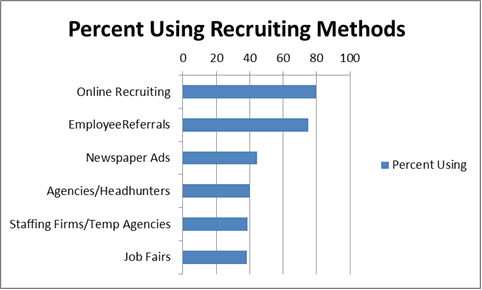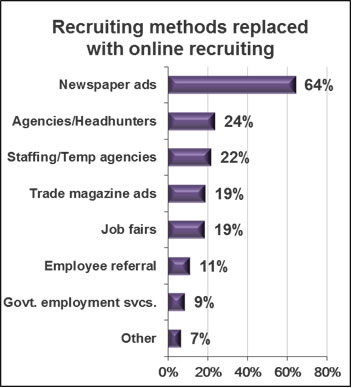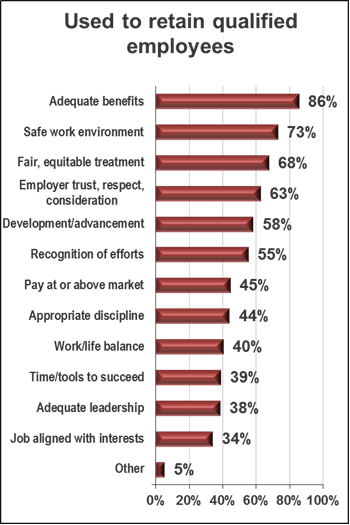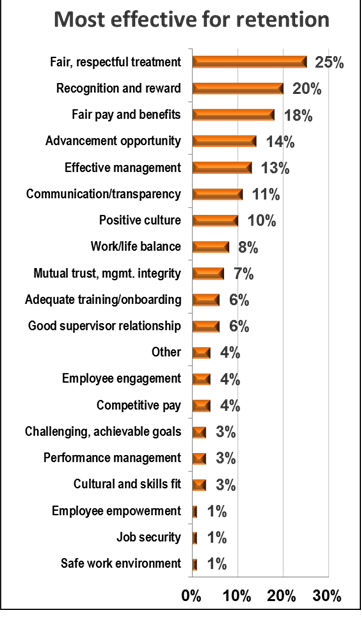We garnered an impressive 1,379 participants in this year’s survey, which was conducted in November 2013. Here are the detailed survey results. How does your organization measure up?
What Recruiting Methods Are Used?
When asked which methods are used to recruit for open positions, online recruiting leads the pack at 79.7%, followed closely by employee referral at 74.9%. Coming in at a distant third are newspaper ads at 44.4%. Employment agencies/headhunters and staffing firms/temp agencies are neck and neck at 39.7% and 38.6%, respectively, with job fairs right on their heels at 38.5%.

Who Has a Recruiting Strategy?
Though an impressive 60.5% of our survey participants have a recruiting strategy, only 29% of them have written documentation, and for 64.4%, it’s mostly cultural habit.
What’s Negotiable for New Employees?
Negotiating the salary on every position is the norm for 16.9%, and for 71.1%, whether the salary is negotiable depends on the position. For 10.4% of survey participants, a candidate takes what is offered or the job goes to the next candidate in line.
As can be seen in the chart below, with regard to benefits, over half (53.8%) of the survey participants who answered the question are willing to negotiate paid time off.

Compensation.BLR.com, now thoroughly reved with easier navigation and more complete compensation information, will tell you what’s being paid right in your state—or even metropolitan area—for hundreds of jobs. Try it at no cost and get a complimentary special report. Read more.
How Successful Is Online Recruiting?
All open positions are posted online for 41% of survey participants who answered the question, and over three-fourths of open positions are posted online for 29.9%. When asked how many advertised jobs are filled from online applicants, 31.7% indicated that over 75% of their jobs are filled that way, and for 21.9%, from 51% to 75% of jobs are filled by online applicants.

Job boards like Monster.com and CareerBuilder.com are the most successful avenue for online recruiting for 30.5% of survey participants. Their own company website, however, is the best bet for 27.4%. Recruiting via online communities such as LinkedIn.com and Spoke.com are more successful for 12.5%. A quick peek into the “other” bucket reveals that CraigsList.com has been a successful option for 3%. When asked what they think of job boards, 39.1% of survey participants indicate they’ve “had some success using them,” and 26.2% have “gotten quite a few good applicants” from them. On the flip side, though, 15.3% have “not had much success using them,” and 10.1% “have not used job boards.”
The positions most successfully recruited online are entry-level at 29.5%, followed closely by professionals at 29%. Mid-level comes in third at 24.2%. Just posting open positions online is the routine for 33.7% of survey participants and searching through posted résumés is an option for 13.1%. Both posting and searching, though, are the path to success for 34%.
E-recruiting is simply another recruiting tool for 27.8%, 30% have not abandoned other recruiting methods in favor of e-recruiting, and 7.7% are still testing the e-recruiting waters. For 33.7%, however, it is their preferred method of recruiting.

Recruiting Expense and Speed
Almost half, 49.8%, have found that online recruiting is less expensive than other recruiting methods, though 23.9% say it’s about the same and 8.7% have found it to be more expensive. For 44.8%, online recruiting typically brings them candidates faster, and for 23.1%, it depends on the position. Online recruiting is slower for 7.3% and about the same for 17.2%.
Online recruiting offers both pros and cons. For example, exposure to a wider audience is an advantage of online recruiting for 78.5%, and ease of use is a positive factor for 53.4%. On the flip side, too many unqualified applicants are a negative for 79.1%, and too many applicants in general are a negative impact of online recruiting for 36.2%.
|
Pros and cons of online recruiting |
|||
|
Advantages |
Disadvantages |
||
|
Exposure to wider audience |
78.5% |
Too many unqualified candidates |
79.1% |
|
Ease of use |
53.4% |
Too many applicants |
36.2% |
|
Cost |
45.2% |
Out-of-town applicants |
32.6% |
|
Reach passive jobseekers |
42.8% |
Spam |
20.4% |
|
Faster time to hire |
34.7% |
Too few applicants |
4.7% |
|
More ad space |
31.0% |
Other |
4.1% |
|
Better candidate matching |
25.1% |
Doesn’t reach broad audience |
3.3% |
|
Other |
2.3% |
|
|
Fewer than 30% use software to track and/or measure their online recruiting. When it comes to the kind of software, it’s all over the map with homegrown databases leading the pack at 5%.
Though 2.4% plan to discontinue online recruiting and 8.2% aren’t sure, 88% plan to continue their online recruiting programs.
How Do Respondents Manage Onboarding?
Getting new employees on board is formalized for 88.5%. It is an ongoing process during the first 1–3 months of employment for 25.9% and is 1–2 hours of orientation with benefits enrollment for 22.7%. Multiple sessions spread across several days within the first week of employment is the norm for 18.1%, and a single, full day is the process for 10.6%. A half day that includes benefits enrollment is utilized by 18.3%.
Management team members participate in the onboarding process for 75.4%. Training on how to successfully onboard new employees is received by 38.3%, and mentors or buddies for new employees are provided by 41.9%.
What’s Working for Retention?
This survey looked at retention from two different perspectives. First, providing a list from which to choose, we asked participants to select the options they utilize to retain qualified employees. Next, providing no list, we asked participants to describe what is most effective when it comes to retaining employees. Many of the responses to both questions were the same, and you can find them in the charts shown in this survey summary.


One participant, however, commented and provided a list of 10 ways (see below) to not just ensure retention but also to develop engaged, loyal employees.
You retain your best employees by encouraging a corporate culture that makes your organization both a great and productive place to work, primarily by:
- Making hiring decisions based on diversity and soft skills as well as experience/expertise.
- Clearly communicating your expectations and always expecting excellence.
- Adequately preparing new employees. Then ensuring all employees continue to have the training and tools they need to do their job excellently.
- Trusting your employees. Allowing them to make some mistakes. Encouraging them to be accountable and to learn from their experiences.
- Recognizing each person has different supervision needs and providing supervision only to the level each individual needs, but monitoring performance.
- Catching employees doing things right. Chatting with employees frequently. Providing positive feedback adequate to that individual’s needs. Encouraging employees to identify and provide their own constructive feedback but don’t hesitate to provide it yourself if necessary.
- Leading by example. Without exception, show only the behaviors you want your employees to display.
- Encouraging individualism within the boundaries of respect and consideration.
- Looking for daily opportunities for transparency. Don’t keep unnecessary secrets.
- Terminating quickly if an employee proves untrustworthy and unsalvageable.
The survey participant also commented that if top management does these things, you will not only retain your employees but also they will be fully engaged and fanatically loyal.
Who Are the 1,379 Survey Participants?
A total of 1,379 individuals participated in this survey, which was conducted in November 2013. Of those who identified themselves, 63% represent privately owned companies, 8% are with public entities, and 28.9% work for government or nonprofit organizations.
The majority (57.5%) of our survey respondents provide HR services to a workforce of 1–250 employees. Another 13.3% provide guidance to 251–500 employees at their organizations, and 10.5% have a workforce of 501–1,000 employees. Companies with more than 1,000 employees account for 18.8% of survey participants.
Fewer than 8% of the employers surveyed have a 50% to 100% unionized workforce. Also, 84.8% have a workforce that is less than 10% union employees. Less than 26.4% of the respondents have a workforce of more than 50% exempt employees.
Over half (52.8%) of the participants are in service industries; 20.1% are in agriculture, forestry, construction, manufacturing, or mining; 8.3% are in wholesale, retail, transportation, or warehousing; and 2.1% are in real estate or utilities.
HR managers and directors account for 47.6% of the survey participants who self-identified, other HR professionals make up 33.3%, 1.2% are benefits professionals, and 17.8% are in other areas with HR responsibilities.

Agreed. One would have to assume there was a good mix or the study wuldon’t have been publicized, but it’s definitely something to keep in mind. Would be interesting to at least know the age range of the highest number of respondents to get an idea of who is/would be most open to using mobile job search tools. Thanks Darren!